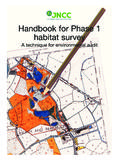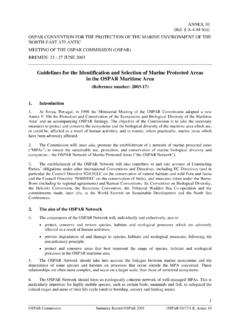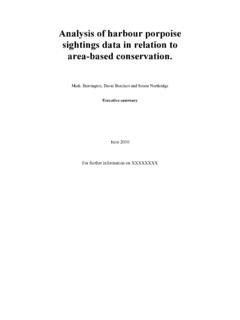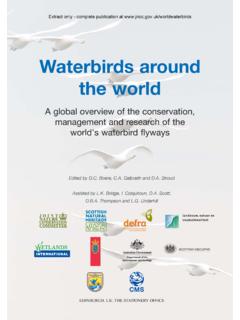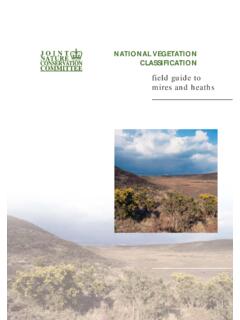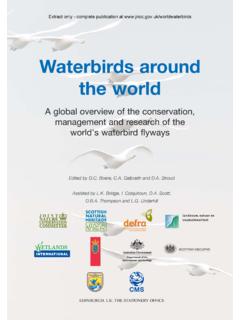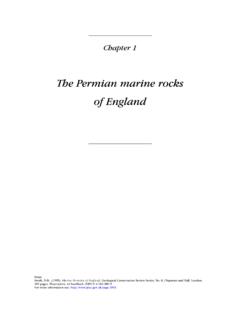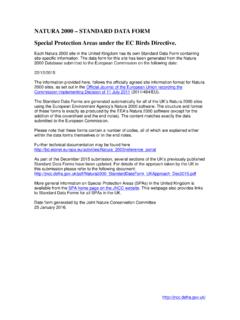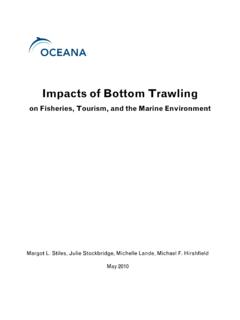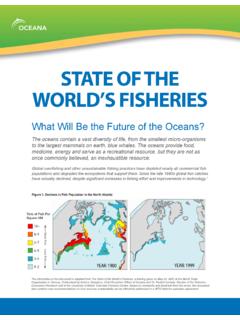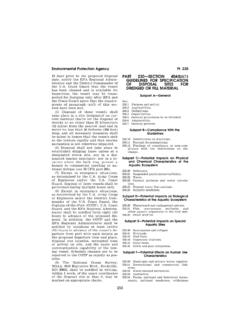Transcription of Supplementary Advice on Conservation Objectives …
1 1 Supplementary Advice on Conservation Objectives for East of Gannet and Montrose Fields Nature Conservation MPA February 2018 2 Contents Introduction .. 3 Table 1. Supplementary Advice on the Conservation Objectives for Offshore deep-sea muds in East of Gannet and Montrose Fields NCMPA .. 5 Attribute: Extent and distribution .. 5 Extent and distribution within the site .. 6 Attribute: Structure and function .. 6 Physical structure: Finer scale topography .. 7 Physical structure: Finer scale topography within the site .. 7 Physical structure: Sediment composition .. 8 Physical structure: Sediment composition within the site.
2 8 Biological structure: Key and influential species .. 9 Biological structure: Key and influential species within the site .. 9 Biological structure: Characteristic communities .. 10 Biological structure: Characteristic communities within the site .. 11 Function .. 11 Function of the feature within the site .. 12 Attribute: Supporting processes .. 12 Hydrodynamic regime .. 13 Hydrodynamic regime within the site .. 13 Water and sediment quality .. 14 Water quality .. 15 Water quality within the site .. 15 Sediment quality .. 16 Sediment quality within the site .. 17 Table 2. Supplementary Advice on the Conservation Objectives for Ocean quahog aggregations in East of Gannet and Montrose Fields NCMPA.
3 18 Attribute: Extent and distribution .. 18 Extent and distribution within the site .. 19 Attribute: Structure and function .. 20 Structure .. 20 Structure within the site .. 21 Function .. 22 Function within the site .. 23 Attribute: Supporting processes .. 24 Hydrodynamic regime .. 24 Hydrodynamic regime within the site .. 25 Supporting habitats .. 25 Supporting habitats within the site .. 26 Water and sediment quality .. 26 Water and sediment quality within the site .. 29 References .. 31 3 Introduction What the Conservation Advice package includes The most up-to-date Conservation Advice for this site can be downloaded from the Conservation Advice tab in the Site Information Centre (SIC) on JNCC s website.
4 The Advice presented here describes the ecological characteristics or attributes of the site s protected features: Offshore deep-sea muds and Ocean quahog aggregations (including subtidal sedimentary habitats as their supporting habitat) specified in the site s Conservation Objectives . These attributes are: extent and distribution, structure and function and supporting processes. Figure 1 below illustrates the concept of how a feature s attributes are interlinked: with impacts on one potentially having knock-on effects on another the impairment of any of the supporting processes on which a feature relies can result in changes to its extent and distribution and structure and function.
5 The information provided in this document sets out JNCC s Supplementary Advice on the Conservation Objectives set for this site. This forms part of JNCC s Conservation Advice package for the site and must be read in conjunction with all parts of the package as listed below: Background document explaining where to find the Advice package, JNCC s role in the provision of Conservation Advice , how the Advice has been prepared, when to refer to it and how to apply it; Conservation Objectives setting out the broad ecological aims for the site; Statements on: o the site s protected feature condition and General Management Approach; o Conservation benefits that the site can provide.
6 And o Conservation measures needed to further the Conservation Objectives stated for the site. Supplementary Advice on Conservation Objectives (SACO) providing more detailed and site-specific information on the Conservation Objectives (this document); and Advice on Operations providing information on those human activities that, if taking place within or near the site, could impact it and hinder the achievement of the Conservation Objectives stated for the site. 4 Collectively, the attributes set out in Tables 1 and 2 below, along with the Objectives set for each of them, describe the desired ecological condition (favourable) for the site s protected features.
7 Each feature within the site must be in favourable condition as set out in the site s Conservation Objectives . All attributes listed in Tables 1 and 2 must be taken into consideration when assessing impacts from an activity. Figure 1. Conceptual diagram showing how a feature s attributes are interlinked and collectively describe favourable condition and contribute to the Conservation Objectives stated for the site. The Objectives listed in Tables 1 and 2 below reflect our current understanding of each protected feature s condition where evidence indicates some of a feature s extent is lost and needs to be recovered or that extent is not lost and needs to be conserved in order to ensure the feature is in overall favourable condition.
8 The rationale for setting each objective is also provided in the explanatory notes, along with reference to supporting evidence from the site. Note that where it is not practical through human intervention to recover a feature s attribute, a conserve objective is set, accompanied by a statement to reflect the impracticality of restoration. Note also that when a conserve objective is set, this does not preclude the need for management, now or in the future. Please see the Conservation measures relating to those activities JNCC consider may require additional management. 5 Table 1. Supplementary Advice on the Conservation Objectives for Offshore deep-sea muds in East of Gannet and Montrose Fields Nature Conservation MPA Attribute: Extent and distribution Objective: Conserve JNCC advise a conserve objective which is based on expert judgement; specifically, our understanding of the feature s sensitivity to pressures exerted by the activities present.
9 Our confidence in the setting of this objective would be improved by long-term monitoring information. Activities should look to minimise, as far as is practicable, changes in substrata and the biological communities associated with Offshore deep-sea muds. Explanatory notes Extent refers to the total area in the site occupied by Subtidal sedimentary habitats and must include consideration of their distribution how spread out they are within a site. A reduction in extent has the potential to alter the biological and physical functioning of Subtidal sedimentary habitat types (Elliott et al., 1998; Tillin and Tyler-Walters, 2014). The distribution of a habitat influences the component communities present, and can contribute to the health and resilience of the feature (JNCC, 2004).
10 The extent of the Subtidal sedimentary habitats within the site must be conserved to their full known distribution. Subtidal sedimentary habitats are defined by: Sediment composition (grain size and type) ( Cooper et al., 2011; Coates et al., 2015; 2016; Coblentz et al., 2015). Some species can inhabit all types of sediment, whereas others are restricted to specific types; and Biological assemblages - See JNCC s Marine Habitats Correlation Table for more detail about the range of biological communities (biotopes) that characterise Subtidal sedimentary habitats in the UK marine environment. In offshore environments, note that Subtidal sedimentary habitats are not typically dominated by algal communities.

